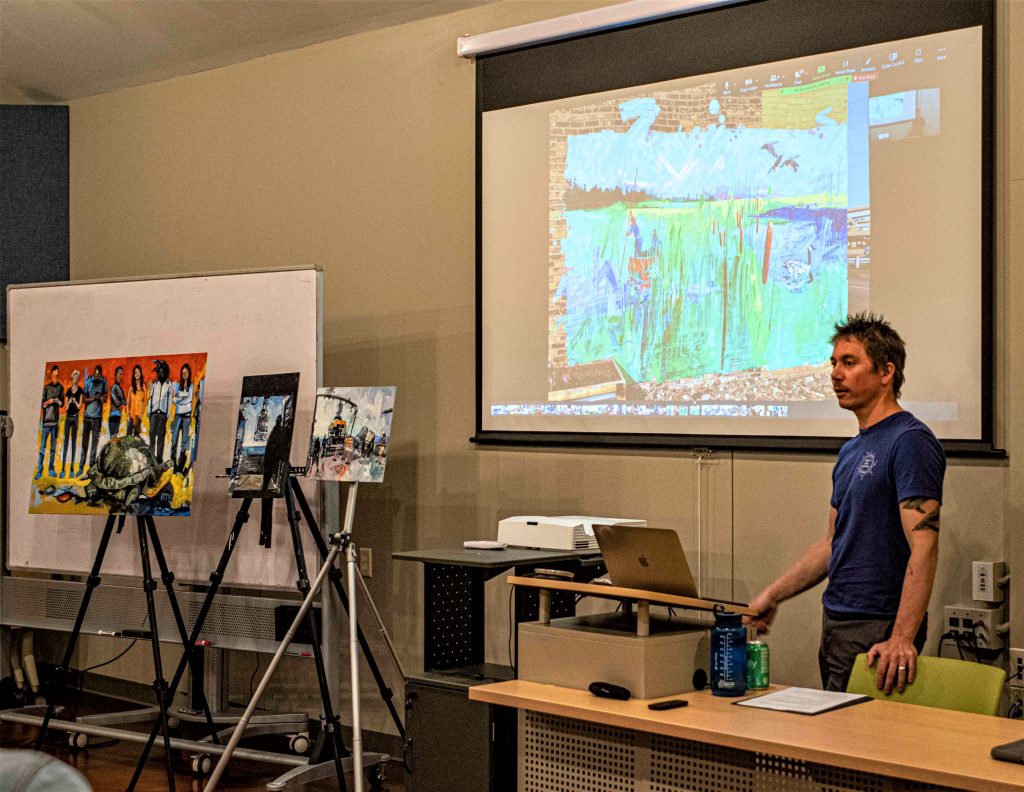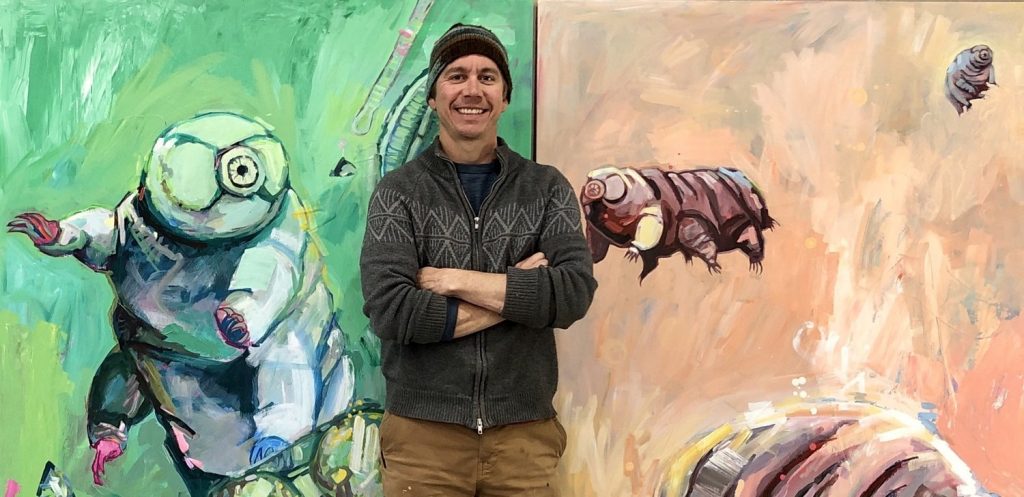
Adam Swanson discussed the intersections between art and science at the April River Talks. He also showed some of his artworks. Image credit: Michael Anderson
Local environmental science painter and muralist Adam Swanson described how he mixes art and science for the April River Talk, held at the Lake Superior Estuarium in Superior.
After he graduated from art school at the University of Minnesota Duluth, he got a job as a carpenter in Antarctica. He worked there periodically for a decade, helping research teams with their carpentry needs, including on their research vessels.
“In 2001, there were all these scientists doing amazing work that I had never heard of before. For instance, I didn’t realize that climate change was caused by human activity but everyone in Antarctica knew that,” Swanson said.
That really struck him. He was “just a working guy” but he admired the scientists’ focus and determination to see their projects through. When he returned to Minnesota, Swanson would paint “little snapshots” of Antarctica when he wasn’t working for pay. “They weren’t really informed by anything real – they were more imaginative or pretty.”
Eventually, he decided to start painting more seriously. “That’s when I started thinking more about the responsibility of scientists to communicate. When I thought about what I wanted to paint, I thought about my time in Antarctica and decided I wanted to be a bridge between scientists and the public,” Swanson said.
He discovered many local projects that deal with climate change, including one in Bovey, Minnesota. He wrote a grant to volunteer time there and paint what he experienced. For his artworks, Swanson takes photos and paints from those.
Swanson has also had the opportunity to visit the Great Lakes Toxicology and Ecology Division Laboratory in Duluth and other local research facilities.
“I was flying by the seat of my pants. I knew there were people (scientists) who would let me into their space because I was polite.” He also went aboard the Blue Heron research vessel, owned by the University of Minnesota Duluth’s Large Lakes Observatory. “I basically just wandered around on board. I wasn’t trying to be an expert. Just like in Antarctica,” Swanson said.
In 2008, Swanson was chosen for an artist residency for two weeks on the Research Vessel Falkor, which is operated by the Schmidt Ocean Institute and travels all around the world. They were studying organisms that live on methane and sulfur in thermal vents. His goal was to capture what was happening on the ship. His tiny studio was in the ship’s wet lab. “I would often have to move all my stuff if someone needed to pipette one thing into another thing,” he said.
Last summer Swanson mentored an artist at the University of Wisconsin’s Trout Lake Research Station in northern Wisconsin. “My student intern was from the Lac du Flambeau Tribe and my science partner worked for the department of natural resources. It was an awesome experience!”
He also paints on commission from photos, paints murals, and applies for grants for art experiences. Recently, he’s been working on a series of paintings of endangered animals in Minnesota. He juxtaposes them with images of people or human activities to show their interconnections and impacts.
“One reason art is a good communicator for science is because it can play around with different ways for people to connect with science. Maybe the moth doesn’t have the right number of legs, or the colors aren’t exactly right. But the artist has that prerogative. I’m not doing scientific illustration. I’m looking for art to push boundaries – push ideas around.”

Adam Swanson stands in front of one of his murals that feature tardigrades. Submitted image.
Swanson has completed several murals with school children, taking their input on the subject matter and having them help with the painting. Other murals are on buildings in Superior, Duluth and Minneapolis. One is inside the Estuarium. Another, about wild rice restoration, is in West Duluth.
Tardigrades are one of Swanson’s recent favorite subjects. These microscopic animals live in diverse environments and are extremely durable. They are also known as water bears or moss piglets. Swanson said, “After coming off the endangered animal series, I wanted something more resilient.”
Swanson paints about 100 works per year. He tries not to make them too loaded with meaning. “I roll through ideas. I take some cool, interesting stuff, do as much research as I can, and then put it together.”
Currently, Swanson is working on a series of 10 large-scale pollinator paintings, which he plans to exhibit from 5-7 p.m., May 10, at the Duluth Art Institute (Lincoln Building).
Make a night of it — attend his open reception early, then come to the next River Talk, which will be held from 6-8 p.m., May 10, in-person at the Lake Superior Estuarium. Steve Kolbe with the University of Minnesota Duluth’s Natural Resources Research Institute will discuss, “How and Where to Find Birds in the St. Louis River Estuary.”


